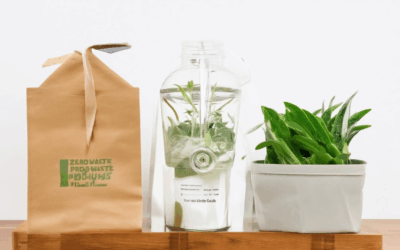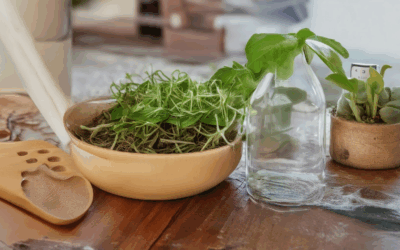Are you ready to transform your home into a plastic-free sanctuary? With the growing demand for sustainable living, reducing plastic use has become not just a trend but a necessity. From kitchen essentials to bathroom basics, there’s a wave of eco-friendly alternatives waiting to replace traditional plastic items. Whether you’re looking to cut down on waste, improve your health, or simply embrace a greener lifestyle, this guide offers practical tips, thoughtful recommendations, and actionable steps to create a plastic-free home. Discover how easy it is to swap out harmful plastics for safer, more durable alternatives, and learn how small changes can make a big difference for both your family and the planet. Let’s dive into the world of plastic-free living and explore the countless ways to make your home healthier and more sustainable than ever before!
Key Takeaways
- Go Plastic-Free: Swap single-use plastics for reusable alternatives like stainless steel bottles, glass containers, and cloth bags.
- Sustainable Clothing: Choose natural fibers like organic cotton, linen, hemp, and Tencel to reduce microplastic release.
- Eco-Friendly Products: Select items made from biodegradable or recycled materials and support brands committed to reducing plastic waste.
- DIY Solutions: Create your own household products using natural ingredients stored in reusable containers.
- Eco-Conscious Shopping: Buy from local and sustainable businesses that prioritize plastic-free packaging.
- Stay Informed: Follow eco-conscious blogs and forums to discover new sustainable living tips and materials.
- Lead by Example: Inspire others by sharing your journey and encouraging them to adopt plastic-free habits.
- Minimize Microplastics: Wash clothes less frequently and air dry them to reduce microplastic shedding.
- Sustainable Living Tips: Adopt habits like reusing items, conserving water, and supporting circular economy initiatives.
- Green Lifestyle Changes: Use cloth produce bags, shop secondhand, and bring your own containers to reduce waste.
- Effective Recycling: Sort recyclables correctly and participate in programs like Patagonia’s Worn Wear initiative.
- Community Impact: Join local cleanups and volunteer with environmental groups to drive broader change.

How to Have a Plastic-Free Home
Creating a plastic-free home involves a combination of awareness, substitution, and sustainable habits. Here’s a step-by-step guide to help you transition to a more eco-friendly living space:
- Kitchen
- Replace plastic wrap with beeswax or cotton fabric wraps.
- Use glass containers for food storage instead of plastic.
- Choose stainless steel or ceramic cookware.
- Invest in reusable silicone food storage bags.
- Bathroom
- Switch to biodegradable toilet paper and bamboo toothbrushes.
- Use glass bottles for shampoo and conditioner.
- Opt for plastic-free menstrual products.
- Look for personal care products packaged in recyclable materials.
- Cleaning Products
- Choose concentrate cleaning solutions in glass or metal bottles.
- Use microfiber cloths instead of disposable ones.
- Make your own cleaning supplies using ingredients like vinegar and baking soda.
- Garden
- Avoid plastic mulch and opt for natural alternatives like wood chips.
- Use metal or clay pots instead of plastic ones.
- Plant native species that thrive in your local environment.
- Clothing and Textiles
- Wash and reuse old towels as dishcloths or rags.
- Choose organic cotton or hemp clothing.
- Avoid synthetic fibers that shed microplastics into the water.
- Food Storage
- Use glass jars or containers for dry goods storage.
- Wrap leftovers in paper towels or reusable cloth napkins.
- Invest in beeswax or silicone food covers.
- Mindset Shift
- Be mindful of your daily habits and identify areas where plastic use can be reduced.
- Prioritize purchasing products with minimal packaging.
- Support local businesses that offer plastic-free alternatives.
By making small, intentional changes, you can significantly reduce your reliance on plastic and create a more sustainable living environment. Remember, every little effort contributes to a bigger change!
What Things Can We Use Instead of Plastic?
Eco Planeta Verde advocates for reducing plastic use by exploring sustainable alternatives that minimize environmental impact. Here are some practical options:
- Glass: Durable and reusable, glass is an excellent substitute for plastic bottles and containers.
- Metal: While heavier, metal items like cans and food containers are long-lasting and recyclable.
- Bamboo: A natural fiber used for utensils, clothing, and home goods, bamboo is biodegradable and renewable.
- Recycled Plastics: Products made from recycled plastic help reduce the demand for virgin plastic.
- Biodegradable Materials: Made from plant-based ingredients, these plastics break down faster in compost facilities.
How to Reduce Plastic Use
Eco Planeta Verde encourages these simple changes to cut down on plastic consumption:
- Bring reusable bags to the store instead of using plastic ones.
- Use cloth menstrual pads instead of disposable ones.
- Invest in a reusable water bottle for daily use.
- Opt for digital receipts via email instead of paper ones.
To learn more about sustainable living tips and eco-friendly products, visit Eco Planeta Verde today!

Gifts for Plastic-Free Lifestyles
Looking for thoughtful gifts that align with a plastic-free lifestyle? Here are some curated options:
- Reusable Items: Opt for items made from sustainable materials like bamboo, cotton, or recycled products. Examples include reusable water bottles, cloth napkins, and stainless steel cutlery.
- Eco-Friendly Products: Choose gifts that reduce plastic consumption, such as biodegradable cleaning supplies, zero-waste beauty products, or eco-friendly kitchenware like glass storage containers.
- DIY Gift Ideas: Create personalized gifts using natural materials. For example, make your own natural bath bombs or craft sets using wool felt and wooden tools.
- Experience Gifts: Consider gifting experiences rather than physical items, such as memberships to eco-tours or workshops focused on sustainability.
- Sustainable Clothing: Look for clothing made from organic fabrics or deadstock materials. Brands like Patagonia and Ecosia offer stylish, eco-conscious apparel.
- Plastic-Free Home Essentials: Provide gifts that help reduce household plastic use, such as compostable kitchen wraps or eco-friendly cleaning kits.
For more inspiration, check out our sustainable living resources on Eco Planeta Verde. We offer guides and tips to help you find the perfect plastic-free gifts!

How to Be 100% Plastic-Free
- Start by assessing your daily habits and identifying areas where plastic is frequently used. Common culprits include single-use plastics like water bottles, food packaging, and disposable items.
- Invest in reusable alternatives. Choose items like stainless steel water bottles, glass containers, and cloth bags to reduce reliance on plastic.
- Reduce your use of plastic wrap and packaging. Opt for bulk purchasing to minimize plastic packaging from stores.
- Evaluate personal care products. Look for brands that use biodegradable or recyclable packaging and avoid microbeads in scrubs.
- Make your own household products. Create your own cleaning supplies using natural ingredients like vinegar and baking soda, stored in reusable containers.
- Support local and sustainable businesses that prioritize plastic-free products and packaging.
- Stay informed about plastic alternatives. Follow eco-conscious blogs and forums to learn about new materials and innovations in sustainable living.
- Encourage others to join the movement. Share your journey and inspire friends and family to reduce their plastic use as well.
What Clothes Don’t Have Microplastics?
Clothes made from natural, plant-based fibers are less likely to release microplastics during wear and washing. Here’s a list of materials to consider:
- Organic Cotton : Grown without synthetic chemicals, organic cotton remains one of the safest options.
- Linen : Made from flax, linen is durable and biodegradable, reducing the risk of microplastic release.
- Hemp : A highly sustainable fabric known for its strength and minimal environmental impact.
- Ramie : Derived from the ramie plant, this soft and breathable fabric is naturally hypoallergenic.
- Kapok : Sourced from the kapok tree, this unique fiber is lightweight and biodegradable.
- Jute : Made from the stalks of jute plants, jute is strong, eco-friendly, and has a low carbon footprint.
- Tencel : A sustainably harvested wood fiber, Tencel is soft and requires less water and energy to process.
- Lyocell : Made from beech trees, Lyocell is a luxurious option that’s gentle on the environment.
To further reduce microplastic exposure, consider washing clothes less frequently and air-drying them. Choosing eco-friendly detergent and avoiding fabric softeners can also help preserve the integrity of natural fibers.
For more sustainable fashion tips, visit our homepage and explore our guides on reducing textile waste.

How to Live a Low Plastic Life
Living a low plastic life is a meaningful way to reduce your environmental footprint while promoting sustainable habits. Here are some practical steps to get started:
- Reduce Single-Use Plastics: Minimize plastic items like water bottles, straws, and disposable packaging. Invest in reusable alternatives like stainless steel bottles and cloth bags.
- Choose Sustainable Products: Opt for products made from recycled materials or biodegradable options. Support brands committed to reducing plastic waste, such as TerraCycle .
- Reuse and Upcycle: Turn everyday items into new creations. For instance, old jars can become planters or organizers. This reduces waste and adds unique charm to your space.
- Conserve Water: Fix leaky pipes and install water-saving devices to cut down on plastic water usage. Shorter showers and efficient irrigation systems also help conserve resources.
- Educate Yourself and Others: Spread awareness by sharing tips with friends and family. Knowledge is the first step toward change, and collective effort can create a bigger impact.
Simple Habits for a Greener Lifestyle
Small changes can lead to significant differences. Try these easy-to-maintain habits:
- Bring Your Own Containers: When purchasing food or beverages, use reusable containers instead of disposable ones. Many stores now offer bulk options to reduce packaging waste.
- Shop Secondhand: Explore thrift stores or online platforms like ThredUp to buy gently used clothing and household items. This reduces the demand for new plastic products.
- Use Cloth Produce Bags: Replace plastic bags with washable, breathable cloth bags for grocery shopping. These are durable and can be reused multiple times.
- Opt for Digital Services: Rely on digital receipts and statements instead of paper ones. This not only saves trees but also reduces the need for plastic envelopes.
Recycling and Disposal
Recycling is essential, but it requires careful handling to ensure materials are processed correctly:
- Separate Recyclables: Make sure to sort items by type—paper, glass, metal, and plastics. Check local guidelines to ensure correct disposal methods.
- Reduce Junk Mail: Subscribe to digital newsletters instead of paper ones to minimize unwanted plastic waste.
- Support Circular Economy Initiatives: Participate in programs like Patagonia’s Worn Wear program , which takes used gear and resells it.
Community Involvement
Join forces with others who share your commitment to sustainability:
- Local Cleanups: Organize or participate in clean-up drives in your neighborhood or nearby areas affected by plastic pollution.
- Advocate for Policies: Support movements that push for bans on single-use plastics or better waste management policies in your community.
- Volunteer with Environmental Groups: Work with organizations focused on coastal cleanup or tree-planting projects to contribute hands-on efforts.
Conclusion
Living a low plastic life isn’t just about individual actions—it’s about fostering a culture of responsibility and sustainability. By making intentional choices daily, we can collectively reduce our reliance on plastic and create a healthier planet for future generations. Start small, stay consistent, and remember every effort brings us closer to a more eco-conscious world.




0 Comments